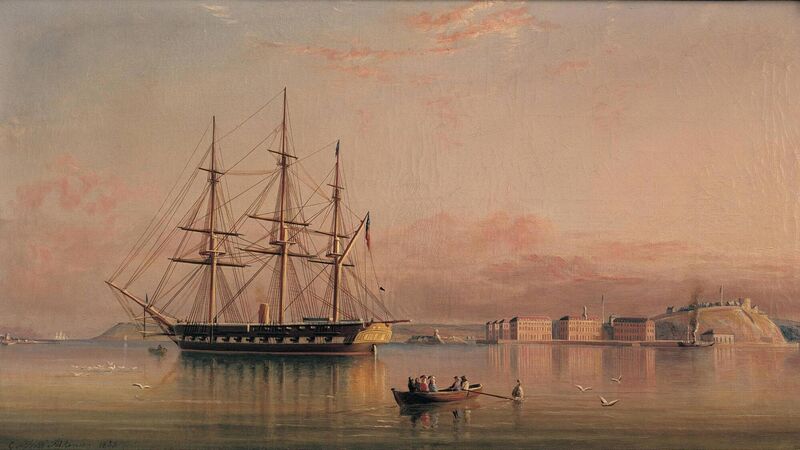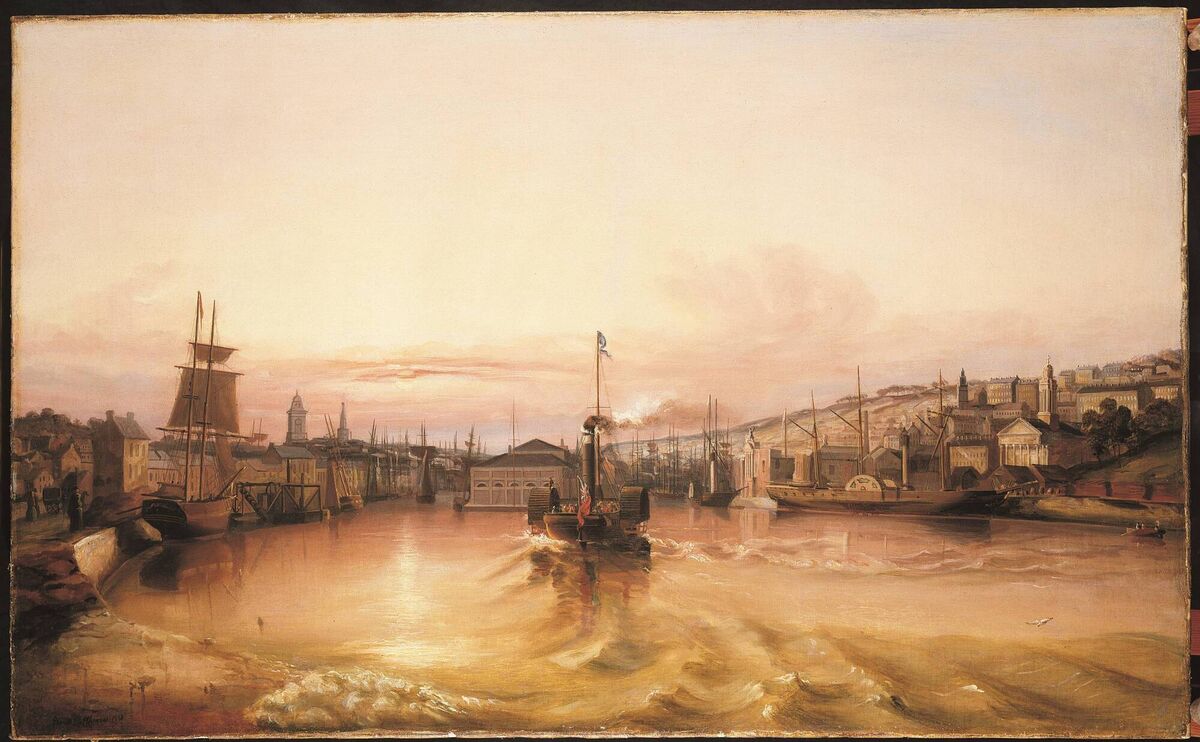Cork In 50 Artworks, No 46: Naval Steam Frigate Moored Off Queenstown, by George Mounsey Wheatley Atkinson

Naval Steam Frigate Moored Off Queenstown, by George Mounsey Wheatley Atkinson.
In February 2021, the Port of Cork Company vacated its headquarters at the Custom House on Custom House Quay. The company had occupied the premises for over a century, but the site is now to be developed as a major new hotel and retail centre, while the Port of Cork staff have moved to new offices in Tivoli and Ringaskiddy.
One major benefit to the city was the decision by the Port of Cork Company to donate its collection of artworks and historical items to the Crawford Art Gallery. The collection includes a silver Admiralty Oar from 1686, an illuminated address to Charles Stewart Parnell, and a ship’s registrar from the Cork Harbour Commissioners that refers to both the Titanic and the Lusitania, along with 17 maritime paintings. Of these, eleven are by the 19th-century Cobh artist George Mounsey Wheatley Atkinson, including one called Naval Steam Frigate Moored Off Queenstown, which dates from 1838.
“Atkinson was a very interesting self-taught painter,” says Dr Michael Waldron, Assistant Curator of Collections & Special Projects at the Crawford. “He was born in 1806. His parents were English, but he was born and grew up in Cobh, or Cove as it was known back then. He was born in the same year as Daniel Maclise, who grew up in Cork and had an art education at the Art School. Atkinson, at the same time, was going to sea, as a carpenter’s apprentice. When he returned to Ireland, he took up a desk job as a surveyor of shipping and emigration.
“He seems to have picked up painting when he came back. Maybe he was always interested, and it’s possible that he might have taken classes, or might have studied other artists locally. He’s a good painter, but you can see he has some limitations. He’s not very keen on figures, for instance. People are kind of suggested in his paintings, they’re slightly cartoonish. But he’s clearly a natural talent.”
It was inevitable, perhaps, that Atkinson would take the ships sailing in and out of the harbour as his primary subject. “Looking out from Cobh, he could watch the ships all day as he worked. But the view from his house on Merview Terrace was also of the harbour. He knew the ships, and who was on them. He knew the captains, and what they were carrying. He knew if they were Navy ships or leisure craft or merchant traders. And that’s all in the paintings.”

Cork had become a major trading port in the 18th century, exporting products such as beef and butter to Britain and the empire. In Wheatley Atkinson’s lifetime, the deep and sheltered harbour on his doorstep also became an important port for the Royal Navy, not least during the Napoleonic Wars, which ended in 1815.
Naval Steam Frigate Moored Off Queenstown is one of three paintings in the Crawford’s collection of Atkinson’s work that show a background of Haulbowline Island, Rocky Island and the hill of Ringaskiddy, each from a slightly different vantage point. “And there, in the foreground, as the point of interest, is the frigate. Atkinson knew exactly the kind of vessel he was painting. This one’s a warship, and the hybrid of its day, as it’s got both a funnel and sails. It’s a tall ship with a steam engine.”
It is not known if Atkinson produced work to commission, or if he simply painted for his own enjoyment. “We do know he exhibited work in the 1840s at the Royal Hibernian Academy, and then again in 1870s. So those were essentially paintings he was doing on spec, in his leisure time. When he wasn’t working, it seems, he was painting. We know he took a sailing trip around Norway in the 1850s, and he sketched as he went. So this was a very personal interest; a hobby, if you like.”
In August 1849, when Queen Victoria visited Cobh on her way to Cork city, she renamed it Queenstown, and Atkinson saw an opportunity to cash in. “He made multiple paintings of the occasion, depicting the pageantry of all the ships in the harbour, and the Royal Yacht. And then he produced lithographic editions of the paintings. We don’t know what size the editions were, but there was a mass market for them. Everyone wanted one. He would have licensed his images to a publishing company, that would then have put a technician on the job of transferring them to print. His depictions of Queen Victoria’s visit were exactly what people wanted, and those prints would have provided him with an excellent income for a time.”
Atkinson’s Naval Steam Frigate Moored Off Queenstown sits easily with his other works in the Crawford’s collection, most notably the painting Paddle Steamer Entering the Port of Cork, which dates from 1842. “The addition of the paintings from the Port of Cork collection means we now have the largest repository of Atkinson’s works,” says Waldron. “We have more than twenty, that range in size from quite small paintings to rather large dramatic ones, and they tell a fuller story of the harbour through the eyes of a single maritime artist.
“We have work by two of his children as well; his daughter Sarah Atkinson, and his son, Richard Peterson Atkinson. It was a family business; all his children became artists. But we don’t know that much else about George Mounsey Wheatley Atkinson, except that he continued living on Merview Terrace, overlooking the harbour, until his death in 1884.”
- The Port of Cork Collection is showing at the Crawford Art Gallery, Cork until August 28. https://crawfordartgallery.ie/


